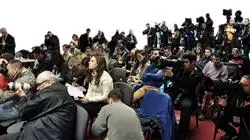University certificate
The world's largest faculty of journalism and communication”
Introduction to the Program
Would you like to reinvent yourself as a journalist by adopting the most innovative and cutting-edge communication strategies? Enrol on this Professional master’s degree and you will achieve it in only 12 months"

The inclusion of Social Networks in the information domain has meant a great advance for Journalism, also encouraged by the digital development and the evolution of ICT. Thanks to this, journalistic communication today is characterized by its immediacy and ubiquity, allowing professionals in this sector to share what is happening in different parts of the world instantaneously. This development has also helped to break down barriers to freedom of the press and freedom of expression in many countries, making high quality, comprehensive and up-to-the-minute information available to more and more people.
In order to provide graduates specializing in this field with what they need to keep up to date with the latest news and communication trends, TECH and its team of experts have developed this very complete and intensive Professional master’s degree in Multimedia Journalism. It is a 100% online program consisting of 1,500 hours of diverse material, with which the professional will be able to work on the most relevant aspects of digital communication, social networks, mobile journalism or data analysis and visualization. They will also deepen their knowledge of the most dynamic and attractive narrative strategies, as well as the guidelines to carry out the optimal and successful management of communication projects.
All this over 12 months of theoretical and practical work led by professionals in the field of journalism with wide ranging and detailed work experience in the sector. This program presents a unique opportunity to perfect your professional skills in a booming area such as Multimedia Journalism, adopting the most innovative communication guidelines and techniques for the development of audiovisual content that will undoubtedly mark a before and after in your career.
If you are looking for a program allowing you to catch up on social media trends and social media storytelling, TECH will give you the keys to succeed with lectures adapted to each one"
This Professional master’s degree in Multimedia Journalism contains the most complete and up-to-date educational program on the market. The most important features include:
- The development of case studies presented by experts in Multimedia Journalism
- The graphic, schematic, and practical contents with which they are created, provide practical information on the disciplines that are essential for professional practice
- Practical exercises where self-assessment can be used to improve learning
- A special emphasis on innovative methodologies
- Theoretical lessons, questions to the expert, debate forums on controversial topics, and assignments for individual reflection
- Content that is accessible from any fixed or portable device with an internet connection
Thanks to the course of this program, you will be able to create dynamic and attractive content, which will help you reach the highest level within a booming sector such as Multimedia Journalism"
The program’s teaching staff includes professionals from the sector who contribute their work experience to this degree program, as well as renowned specialists from leading societies and prestigious universities.
The multimedia content, developed with the latest educational technology, will provide the professional with situated and contextual learning, i.e., a simulated environment that will provide immersive learning designed for real situations.
This program is designed around Problem-Based Learning, whereby the professional must try to resolve the different professional practice situations that arise during the academic year. For this purpose, the student will be assisted by an innovative interactive video system created by renowned and experienced experts.
Boost your creative and communicative side with a program that will allow you to learn the journalistic trends that are currently at the forefront in detail"

Are you looking for a theoretical and practical program that can provide you with the essentials to carrying out an entrepreneurial project in the field of information? If the answer is yes, you have the perfect academic choice"
Why study at TECH?
TECH is the world’s largest online university. With an impressive catalog of more than 14,000 university programs available in 11 languages, it is positioned as a leader in employability, with a 99% job placement rate. In addition, it relies on an enormous faculty of more than 6,000 professors of the highest international renown.

Study at the world's largest online university and guarantee your professional success. The future starts at TECH”
The world’s best online university according to FORBES
The prestigious Forbes magazine, specialized in business and finance, has highlighted TECH as “the world's best online university” This is what they have recently stated in an article in their digital edition in which they echo the success story of this institution, “thanks to the academic offer it provides, the selection of its teaching staff, and an innovative learning method aimed at educating the professionals of the future”
A revolutionary study method, a cutting-edge faculty and a practical focus: the key to TECH's success.
The most complete study plans on the university scene
TECH offers the most complete study plans on the university scene, with syllabuses that cover fundamental concepts and, at the same time, the main scientific advances in their specific scientific areas. In addition, these programs are continuously being updated to guarantee students the academic vanguard and the most in-demand professional skills. In this way, the university's qualifications provide its graduates with a significant advantage to propel their careers to success.
TECH offers the most comprehensive and intensive study plans on the current university scene.
A world-class teaching staff
TECH's teaching staff is made up of more than 6,000 professors with the highest international recognition. Professors, researchers and top executives of multinational companies, including Isaiah Covington, performance coach of the Boston Celtics; Magda Romanska, principal investigator at Harvard MetaLAB; Ignacio Wistumba, chairman of the department of translational molecular pathology at MD Anderson Cancer Center; and D.W. Pine, creative director of TIME magazine, among others.
Internationally renowned experts, specialized in different branches of Health, Technology, Communication and Business, form part of the TECH faculty.
A unique learning method
TECH is the first university to use Relearning in all its programs. It is the best online learning methodology, accredited with international teaching quality certifications, provided by prestigious educational agencies. In addition, this disruptive educational model is complemented with the “Case Method”, thereby setting up a unique online teaching strategy. Innovative teaching resources are also implemented, including detailed videos, infographics and interactive summaries.
TECH combines Relearning and the Case Method in all its university programs to guarantee excellent theoretical and practical learning, studying whenever and wherever you want.
The world's largest online university
TECH is the world’s largest online university. We are the largest educational institution, with the best and widest online educational catalog, one hundred percent online and covering the vast majority of areas of knowledge. We offer a large selection of our own degrees and accredited online undergraduate and postgraduate degrees. In total, more than 14,000 university degrees, in eleven different languages, make us the largest educational largest in the world.
TECH has the world's most extensive catalog of academic and official programs, available in more than 11 languages.
Google Premier Partner
The American technology giant has awarded TECH the Google Google Premier Partner badge. This award, which is only available to 3% of the world's companies, highlights the efficient, flexible and tailored experience that this university provides to students. The recognition as a Google Premier Partner not only accredits the maximum rigor, performance and investment in TECH's digital infrastructures, but also places this university as one of the world's leading technology companies.
Google has positioned TECH in the top 3% of the world's most important technology companies by awarding it its Google Premier Partner badge.
The official online university of the NBA
TECH is the official online university of the NBA. Thanks to our agreement with the biggest league in basketball, we offer our students exclusive university programs, as well as a wide variety of educational resources focused on the business of the league and other areas of the sports industry. Each program is made up of a uniquely designed syllabus and features exceptional guest hosts: professionals with a distinguished sports background who will offer their expertise on the most relevant topics.
TECH has been selected by the NBA, the world's top basketball league, as its official online university.
The top-rated university by its students
Students have positioned TECH as the world's top-rated university on the main review websites, with a highest rating of 4.9 out of 5, obtained from more than 1,000 reviews. These results consolidate TECH as the benchmark university institution at an international level, reflecting the excellence and positive impact of its educational model.” reflecting the excellence and positive impact of its educational model.”
TECH is the world’s top-rated university by its students.
Leaders in employability
TECH has managed to become the leading university in employability. 99% of its students obtain jobs in the academic field they have studied, within one year of completing any of the university's programs. A similar number achieve immediate career enhancement. All this thanks to a study methodology that bases its effectiveness on the acquisition of practical skills, which are absolutely necessary for professional development.
99% of TECH graduates find a job within a year of completing their studies.
Professional Master's Degree in Multimedia Journalism
.
Living in a globalized society, in constant technological growth, has led to work such as journalism to adapt their ways of transmitting information through different media; either in written, sound, animation, or image and video format. In this way, the professional is able to reach a greater number of audiences to meet the needs of readers, listeners, viewers and users of social networks. Given this scenario, the demand for experts in the area is increasing, therefore, TECH Global University has developed a complete Professional Master's Degree in Multimedia Journalism, which covers in its curriculum the most innovative and updated topics in the education sector. Through this online program, designed with a theoretical-practical approach, you will learn essential aspects such as digital communication and mobile journalism, content marketing, data reporting, and audiovisual and transmedia production for any format; which will help you add dynamism to the communicative product, being more attractive and easy to consume for the end user. Throughout the 12 months it takes to master these topics, you will achieve to empower your skills in the management of digital tools, to use the most avant-garde and innovative journalistic strategies of the moment.
Specialize in transmitting information in multiple formats
.
The evolution that journalism has undergone in recent years, adapted to new media and methods of information consumption, have made the communicative work more accessible to all. Therefore, during the development of the syllabus of this Master, TECH and its team of experts selected the most innovative and relevant information of multiplatform communication to provide high quality training. In order to facilitate your learning process, we designed dynamic lessons, complemented with graphic content and practical exercises that will reinforce your knowledge in the area. This is how you will delve into the ubiquity of reporting, audiovisual culture, transmedia narrative, digital storytelling, data visualization and coverage, and journalistic production models. As a result of this, you will be a specialist in applying more dynamic narrative strategies, to successfully carry out the management of multimedia communication projects.







